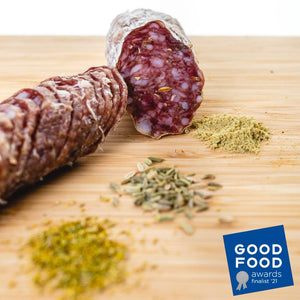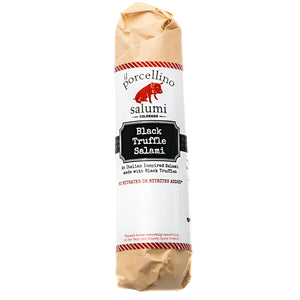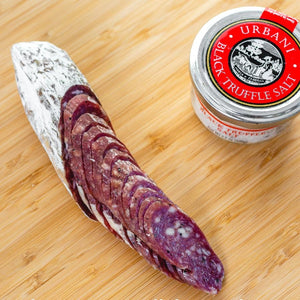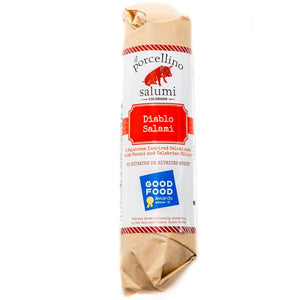We get many questions from our customers asking what's in our sausage and tips on making sausage at home. We've provided answers to individuals, and we have hosted some classes at our retail shop, but I figured this curiosity is in the minds of many, so here is how we approach sausage making.
What is sausage?
Merriam-Webster defines sausage as "a highly seasoned minced meat (such as pork) usually stuffed in casings of prepared animal intestine." Great, now you know the true definition.

Though Merriam-Webster states "usually," I'll highlight that sausage can also be loose meat that can be formed into patties. Breakfast sausage is one most people recognize.
What are sausages made out of?
Most sausage is made from pork, but it can be made out of just about any animal.

The real secret behind making delicious sausage is in the addition of pork fat. A) Because it's delicious and provides flavor. B) Because it transforms the texture of the ground meat into a supple and moist product.
We pretty much exclusively make pork sausages at our retail store in Denver. Typically, we butcher one hog a week and use the picnic shoulder, excess fat, and trim to produce fresh sausages.

We will occasionally make lamb sausage and duck sausage. Lamb sausages will sometimes have the addition of pork fat in the recipe. However, duck sausage is usually 100% duck since the animal is very fatty to start.
Our Summer Sausage is a 60/40 blend of pork and beef that is fermented and smoked. We like the texture and flavor that the lean beef added to the fattier pork shoulder. Our unique blend of spices makes it our most popular sausage. It will be available at all Whole Foods stores in the Rocky Mountain Region in late December!

How is sausage made?
The sausage-making process is relatively straightforward. I believe it is something that just about any home cook can accomplish with the proper equipment and techniques.
Let's start with the ingredients!

To make a proper pork sausage, you should use a pork butt or pork picnic shoulder. Both come from the pig's shoulder area and naturally have the appropriate ratio of meat to fat. Picnic shoulders cost less per pound but have more connective tissue and sinew to remove than a pork butt.
Most butcher shops should be able to sell you pork shoulder butts or pork picnic shoulders.
If you can, source heritage breed pork such as Berkshire or Duroc breeds. The meat from these pig breeds will have a beautiful red color and plenty of intramuscular fat. Plus, hopefully, you will be supporting a small local family farm.
Next, make sure to use premium spices. Quality spices are essential to creating a well-rounded flavor that doesn't dry out the sausage.

I suggest seeking out a local spice purveyor, as their spices will be much fresher than anything at your local grocery store. In Colorado, the best local spice purveyors are Italco Foods, Savory Spice Shop, and The Spice Guy.
If you add any wine or beer to your sausage, don't skimp on the quality. Add something to the recipe that you would like to drink.

Sausage casings are a crucial ingredient you should not overlook. I would highly recommend sourcing casings from one of two online resources. The Craft Butchers' Pantry and Butcher and Packer offer great products. Both resources provide a wide variety of natural casings for any homemade sausage.
Again, don't skimp on quality ingredients.
As far as equipment goes, you will most importantly need a meat grinder (not an attachment to your KitchenAid), a sausage stuffing machine, a good butchering knife, and a sausage pricker.
If you are going to ferment any sausages, they will need to be tied to hang. I recommend using a hemp twine instead of standard cotton butcher twine. Hemp twine is much stronger.

If you are going to smoke sausage, you will need a smoker that can hold a couple of feet of hanging sausage. You may be able to rig something in your current smoker too.
il porcellino salumi's sausage-making process is not drastically different than anybody else's. It all starts with the high-quality ingredients we harped about above.
First, we breakdown the meat. We start by trimming the raw pork, removing any unwanted sinew or silver skin and any glands that are in the meat. We cut the pork into 1"x1" pieces approximately. The pork pieces need to be small enough to go through the meat grinder.

We season the meat accordingly before grinding it. Then the meat sits overnight in the refrigerator so that the seasonings and spices really penetrate the raw pork.
The next day, we grind the pork on the medium die setting of the meat grinder. Then we take approximately ⅓ of the ground meat and grind it a second time. We grind a portion of the meat a second time because it helps the sausage get a strong bind, so the meat sticks together. The last thing you want is sausage with holes or air pockets in it.

Now it's time to stuff the sausage into casings!
Typically, natural sausage casings come packed in salt. It's important to soak the casings under warm, running water to leach the casings of the salt. It usually takes 15 - 20 minutes to have them free and clear of salt. Plus, running warm water through the casings helps "prime" them to be stuffed with meat.
Next, we add the ground and seasoned pork to the sausage stuffing machine. Ensure the meat is packed into the stuffer tightly so that there is no air amongst your meat farce. If you're following along, make sure your sausage casings are rolled onto the stuffing tube.

You're going to crank the sausage stuffer down slowly, so the press is touching the meat, and the meat is starting to come out of the tube. The best practice to stuffing casings is not to overstuff them because you will need room to create the actual sausage links. So, fill your casings with the meat farce rather loosely.
Once the casings are all full, figure out how big you want your sausage links to be. A good point of measurement is approximately 5 inches. Between your thumb and forefinger, you will "pinch and twist" the casing at 5" to tighten up your sausage. Repeat and repeat until you have as many links as desired.

Once you've twisted your sausage links, let them cool in the refrigerator. When the sausages cool, they firm up a bit. Once cooled and firmed, cut between the links to make portions that are easier to handle. Or cut them into individual sausage links.

Please wait until the next day to cook them.
As noted above, you can choose to ferment or smoke your sausages at this point. Fermented sausage is a whole different topic for discussion, as at that point, we are entering into the realm of meat science and lacto-fermentation. We will address that process in a different blog post!
You can cook raw sausage directly. Sous vide cooking in a hot water bath cooks the sausage perfectly because you can keep the temperature a constant 150 degrees. You can grill raw sausages, but they can over-cook easily due to the high heat. Boiling the sausages in beer (beer poaching) imparts some nice flavor into the sausage. Many people are familiar with beer-poached brats. Beer poaching is a great way to cook them through before crisping the sausage on the grill.

Are sausages unhealthy?
Because there are so many different types of sausage, it's hard to generalize whether they're healthy or not. Overall, sausages are not unhealthy, but different sausages will have different ingredients. Some might have more sugar or salt than others or include an ingredient that doesn't match well with individual dietary requirements. I'll say the same thing I've said when we discussed other meats' health impacts, consult with your doctor.
Pre-cooked vs. Uncooked Sausage
All sausages start raw. But when you buy sausage at your local store, it may come fresh (raw) or pre-cooked. Packaged sausage should state whether it's raw or cooked. If you're buying unpackaged sausage, you'll need to ask the person selling it to you.
Fresh sausages are uncooked. An example would be the sausages you get at the end of the sausage-making process we described above. Fresh sausages will need to be cooked through before eating. You can get fresh sausages as links and whole sausage, which is generally formed into patties when cooked.

Pre-cooked sausages are as they sound. Since they're pre-cooked, you don't need to worry about cooking through all the raw meat. I do recommend heating these sausages to bring out their best flavor and make them more appetizing.
Smoked sausages are my absolute favorite type of cooked sausage. I think the flavor you get from a properly smoked sausage is second to none. At il porcellino salumi, we like smoking with hickory or peach wood. Hickory gives you a classic smoke flavor, and peach wood gives a sweeter smoke flavor.

If you live in Denver, see our friends at Proud Souls BBQ for all of your wood and barbecue smoking needs. They are experts!
The most important cooking technique to understand when you are smoking is low and slow. You want the internal temperature of your sausage to reach 150 degrees slowly. You don't want to get that temperature quickly.
We typically smoke our sausages at a temperature of 185 degrees. This temperature allows the product to get a lot of smoke flavor while not overcooking it. Some favorite examples of smoked sausages are Andouille, Kielbasa, Polish HotLink, and Summer Sausage.
Types of Sausage to Know (Including Ones We Make)
Summer Sausage: Summer Sausage originally got its name because it could be kept without refrigeration until opened. It's usually made with a mixture of pork and other meat like beef or venison and can be smoked or dried. We make ours with a mix of beef and pork and smoke it on hickory wood. We recommend refrigerating ours. However, taking it on an afternoon hike in the mountains as a snack is one of life's true rewards! It will last just fine out of refrigeration for a few hours.

Kielbasa: Kielbasa is the Polish term for sausage, but it's come to mean a particular type of sausage in the US. It's usually made with pork and has become recognizable for its horseshoe shape but does not always come in that form. A typical seasoning in Kielbasa sausage involves a fair amount of garlic, black pepper, and marjoram.

Bratwurst: A Bratwurst is a German-style sausage typically ground a little more coarsely than, say, a Summer Sausage. We make our brats with the addition of local beer from Breckenridge Brewery to give them extra flavor and to make them ultra juicy! I think Bratwursts are best enjoyed on the grill with friends, a six-pack, and a sunny day.

Andouille: Andouille is a Cajun-style sausage that can be traced back to French roots but made popular in New Orleans through Cajun cuisine. Typically found in dishes such as Gumbo or Jambalaya, this smoked sausage is packed full of flavor from paprika, cayenne, thyme, and chile flakes. We smoke ours on pecan wood for a more traditional flavor.

Chorizo: The roots of Chorizo Sausage can be traced back to Mexico. It has many different flavor profiles depending on what part of the country you are in. Typical seasonings can include paprika, garlic, oregano, and black pepper. Chorizo is often made and sold raw in a bulk pack without casing. Non-cased chorizo allows the customer to cook the sausage down and maximize the flavor that comes out in soups and stews.

Making sausage can be a lot of fun. You can test out different seasonings and ingredients until you find a recipe that knocks your socks off. Don't let the process scare you!
We test out new flavors all the time. We have several mad sausage scientists making mouthwatering flavors daily. Our retail store always has tasty sausages available.

Our Breckenridge Brewery beer-flavored brats are available for wholesale. Contact us to add them to your menu and/or retail inventory!







